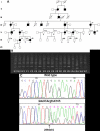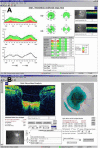Novel LMX1B mutation in familial nail-patella syndrome with variable expression of open angle glaucoma
- PMID: 17515884
- PMCID: PMC2669506
Novel LMX1B mutation in familial nail-patella syndrome with variable expression of open angle glaucoma
Abstract
Purpose: To describe the genetic and clinical findings in a large Spanish pedigree with nail-patella syndrome (NPS) and to investigate the expressivity of open angle glaucoma (OAG) in the family members.
Methods: All individuals underwent a complete ophthalmologic examination, including optical coherence tomography (OCT) of the optic disc and peripapillary region and ultrasound pachymetry. Screening for mutations in the LMX1B gene was performed by denaturing gradient gel electrophoresis and direct genomic sequencing analysis.
Results: Ten family members had NPS, seven with varying degrees of ocular hypertension (OHT). Only one of these had advanced OAG. The others showed high pachymetry values and OCT retinal nerve fiber layer (RNFL) thickness above the normal values. Screening for mutations in the exonic and flanking sequences of the LMX1B gene showed a deletion of one G (289delG) within the coding sequence of exon 3 at codon 97, resulting in a frame shift that creates a premature stop at codon 105 (E97fsX105), predicting a truncated protein. This mutation was present in all NPS patients and absent in the unaffected family members.
Conclusions: A novel mutation in the homeobox transcription factor LMX1B causes NPS in a family with variable expressivity of the syndrome, including OAG. The pathogenic mechanism resulting from the mutation is presumably haploinsufficiency rather than a dominant negative effect, which would explain the clinical variability in this family. All NPS OHT patients had considerably thick corneas and RNFL.
Figures



References
-
- Lichter PR, Richards JE, Downs CA, Stringham HM, Boehnke M, Farley FA. Cosegregation of open-angle glaucoma and the nail-patella syndrome. Am J Ophthalmol. 1997;124:506–15. - PubMed
-
- Farley FA, Lichter PR, Downs CA, McIntosh I, Vollrath D, Richards JE. An orthopaedic scoring system for nail-patella syndrome and application to a kindred with variable expressivity and glaucoma. J Pediatr Orthop. 1999;19:624–31. - PubMed
-
- Knoers NV, Bongers EM, van Beersum SE, Lommen EJ, van Bokhoven H, Hol FA. Nail-patella syndrome: identification of mutations in the LMX1B gene in Dutch families. J Am Soc Nephrol. 2000;11:1762–6. - PubMed
Publication types
MeSH terms
Substances
LinkOut - more resources
Full Text Sources
Research Materials
